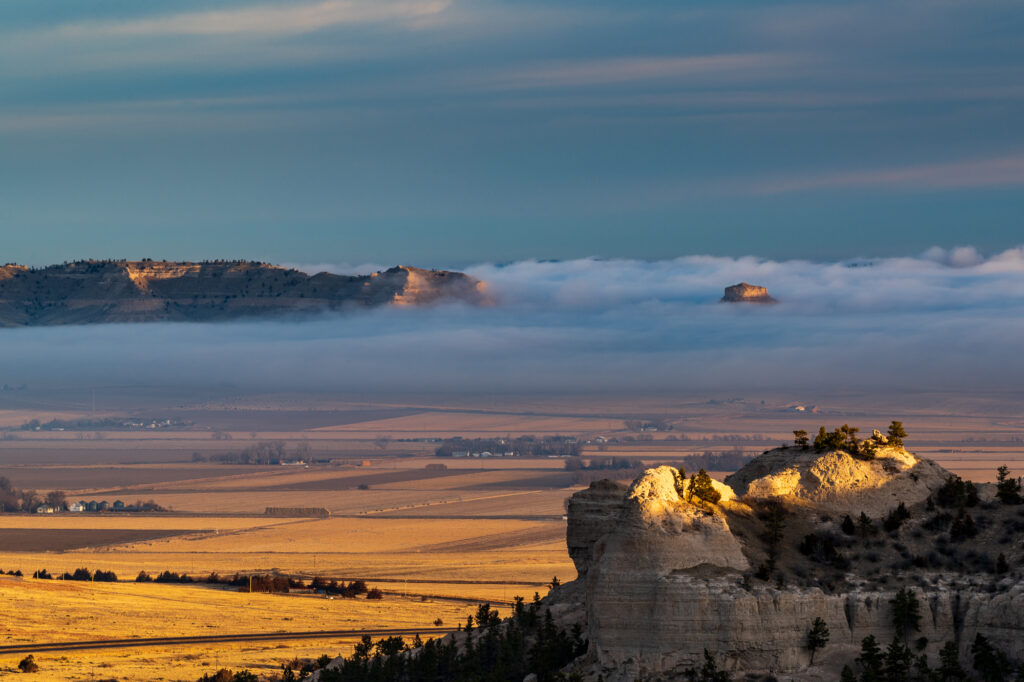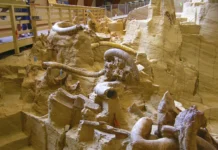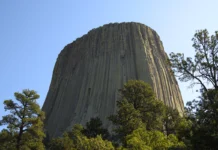| NEBRASKA |
Scotts Bluff National Monument boasts a captivating history that dates back thousands of years, starting with its Native American heritage. The area surrounding Scotts Bluff was once inhabited by Native American tribes like the Lakota Sioux, Cheyenne, Arapaho, and Pawnee. These tribes relied on the region for sustenance, engaging in hunting, gathering, and trading activities. Today, visitors can marvel at the remnants of this rich cultural heritage, including artifacts like tipi rings and stone tools, which provide fascinating glimpses into the lives of the indigenous peoples who called this area home.
Oregon Trail Era: In the mid-19th century, Scotts Bluff gained prominence as a landmark along the Oregon Trail. This historic trail served as a major route for emigrants heading westward to Oregon, California, and other parts of the western United States. The towering presence of Scotts Bluff served as a landmark, indicating that travelers were nearing the Rocky Mountains. The monument witnessed the passage of thousands of pioneers who endured hardships and challenges on their journey.
Fort Mitchell and Military Use: During the 1850s, the U.S. Army established Fort Mitchell near Scotts Bluff as a military outpost to protect settlers and travelers along the Oregon Trail. The fort’s primary purpose was to maintain peace and provide a sense of security during a period of increased tensions with Native American tribes. However, the fort was short-lived and was abandoned in 1857.
Homesteaders and Settlers: Following the decline of Fort Mitchell, the region around Scotts Bluff attracted homesteaders and settlers who sought to establish farms and communities in the area. The fertile lands and access to water sources, such as the nearby North Platte River, made it an appealing location for agricultural activities.
Establishment of the Monument: Recognizing the historical and geological significance of Scotts Bluff, President Woodrow Wilson designated it as a national monument in 1919. The monument’s purpose was to preserve and protect the unique landscape, historical trails, and cultural heritage associated with the area.
Development and Preservation: Over the years, the National Park Service has worked to develop and maintain Scotts Bluff National Monument for the enjoyment and education of visitors. Facilities, such as the visitor center, exhibits, and interpretive trails, have been established to provide insights into the monument’s history, geology, and natural environment.
Scotts Bluff National Monument showcases fascinating geological features that have evolved over millions of years.
Formation and Composition: The geological formations at Scotts Bluff National Monument primarily consist of sedimentary rock layers that were deposited over an extended period. These layers were formed during the Oligocene epoch, approximately 34 to 23 million years ago. The monument is composed of various types of rock, including sandstone, shale, limestone, and volcanic ash deposits.

Erosion and Weathering: The striking features seen at Scotts Bluff, such as cliffs, spires, and buttes, are a result of erosion and weathering processes that have shaped the landscape over millions of years. The North Platte River and its tributaries have played a significant role in carving out the bluffs and canyons, exposing the underlying rock layers.
Sentinel Rock: One of the most prominent features within Scotts Bluff National Monument is Sentinel Rock. This towering sandstone formation rises about 480 feet (146 meters) above the surrounding plains. Sentinel Rock is made up of layers of sandstone that have been resistant to erosion, standing as a testament to the monument’s geological history.
The Chimney Rock Formation: While not part of Scotts Bluff National Monument itself, nearby Chimney Rock is another notable geological formation associated with the area. It is composed of layers of volcanic ash and sedimentary rock. Chimney Rock served as a prominent landmark along the Oregon Trail, guiding pioneers on their westward journey.
Fossils and Paleontological Significance: The sedimentary rock layers at Scotts Bluff National Monument preserve a record of prehistoric life. Fossils, such as plant remains, invertebrate shells, and mammal bones, have been discovered within the rock formations. These fossils provide insights into the ancient ecosystems and help scientists understand the region’s paleontological history.
Geological Time Scale: The rock layers at Scotts Bluff National Monument represent a snapshot of Earth’s geological history. The monument’s formations were formed during the Oligocene epoch, which was a time when significant geological events, climate changes, and the evolution of life were occurring on a global scale.
Visitors to Scotts Bluff National Monument can explore the geology of the area through interpretive trails, exhibits, and ranger-led programs. These resources offer a deeper understanding of the monument’s geological processes, the forces that shaped the landscape, and the unique features that make it a captivating destination for geology enthusiasts.
Today, Scotts Bluff National Monument stands as a testament to the pioneering spirit and the significance of the Oregon Trail in American history. It offers visitors the opportunity to explore the trails, appreciates the panoramic views, and gain a deeper understanding of the challenges faced by those who traveled through this remarkable landscape.































